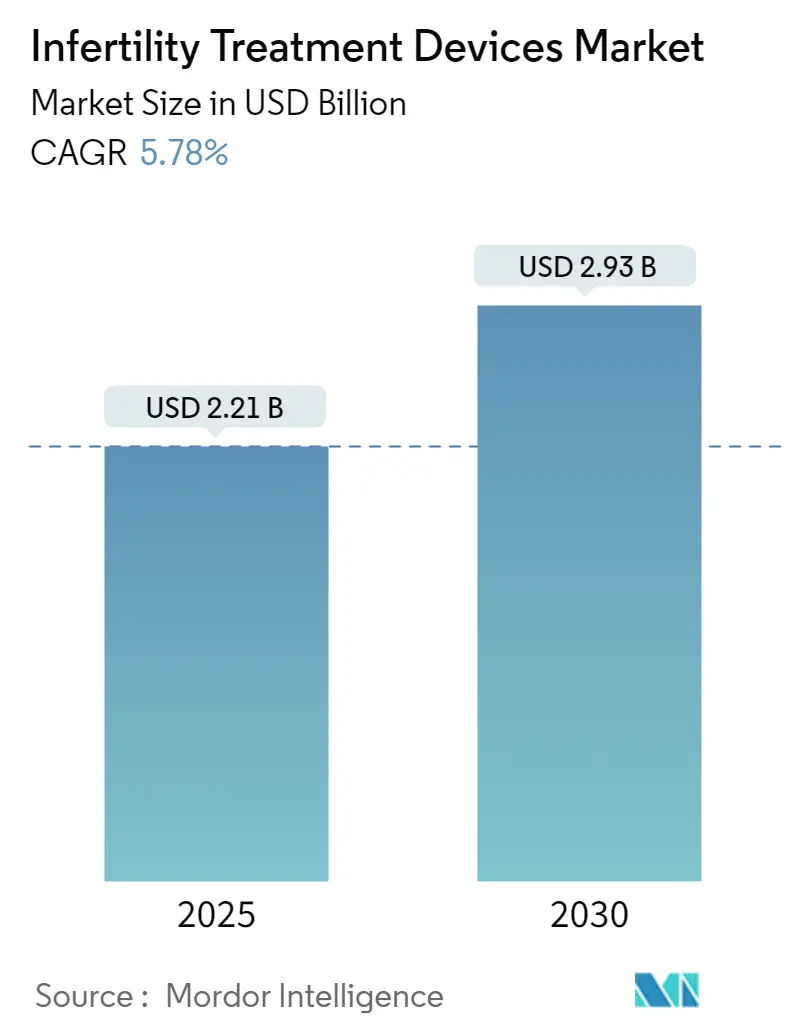
| Study Period | 2019 - 2030 |
| Market Size (2025) | USD 2.21 Billion |
| Market Size (2030) | USD 2.93 Billion |
| CAGR (2025 - 2030) | 5.78 % |
| Fastest Growing Market | Asia Pacific |
| Largest Market | North America |
| Market Concentration | Medium |
Major Players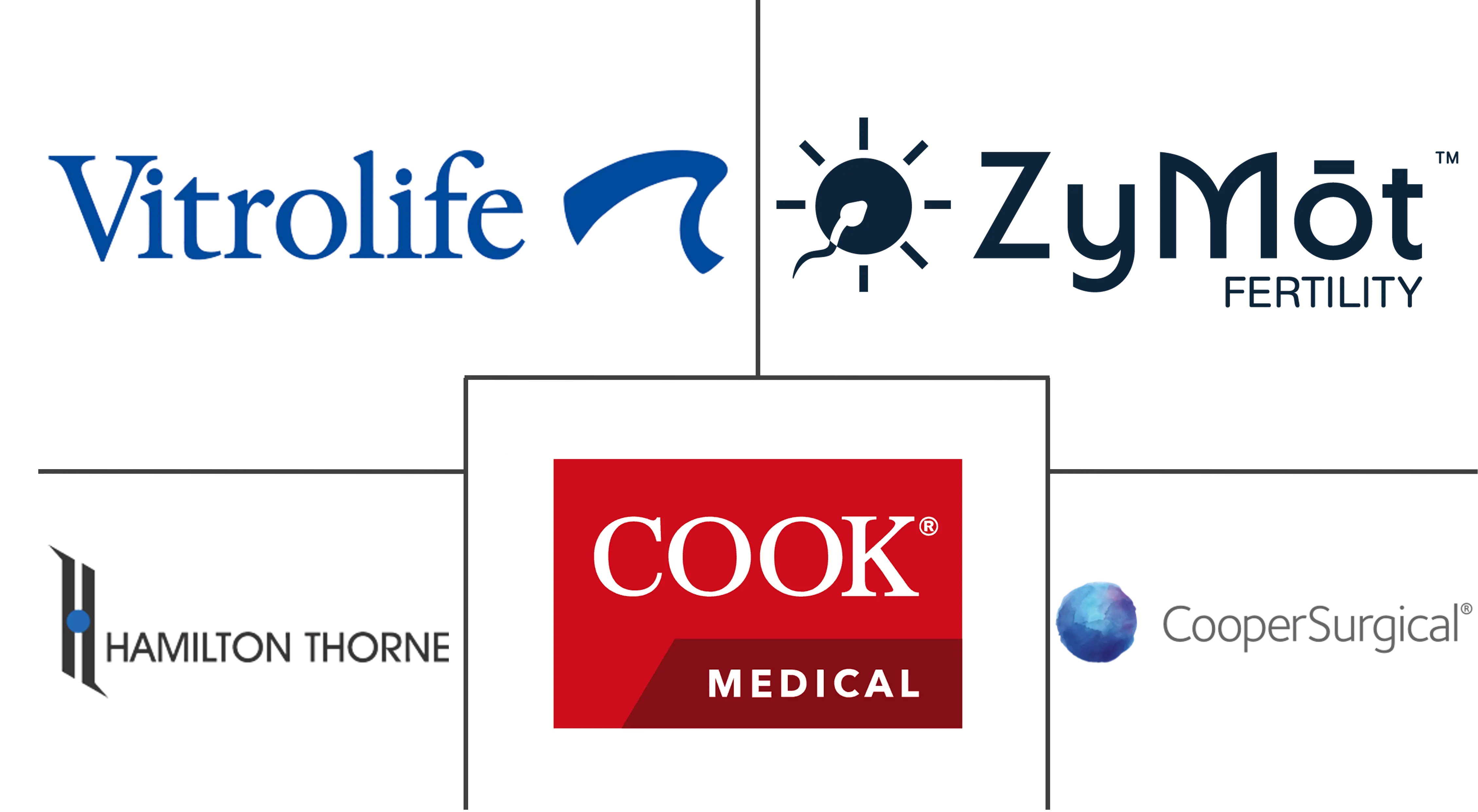
*Disclaimer: Major Players sorted in no particular order |
Infertility Treatment Devices Market Analysis
The Infertility Treatment Devices Market size is estimated at USD 2.21 billion in 2025, and is expected to reach USD 2.93 billion by 2030, at a CAGR of 5.78% during the forecast period (2025-2030).
The infertility treatment devices industry is experiencing significant transformation driven by technological advancements and changing demographic patterns. Advanced technologies like microfluidic systems and automated embryo assessment platforms are revolutionizing fertility treatments, making them more precise and efficient. In March 2022, researchers at Florida Atlantic University's College of Engineering and Computer Science developed a groundbreaking microfluidic chip-based device for sperm sorting that is not only cost-effective but also provides enhanced efficiency in isolating healthy sperm directly from semen. This innovation represents the industry's shift towards more sophisticated, yet accessible treatment solutions.
The market is witnessing a notable trend towards the integration of artificial intelligence and machine learning in fertility treatments. These technologies are being increasingly employed in embryo selection processes, improving success rates and reducing the time required for procedures. The emergence of lab-on-chip technologies and automated platforms has significantly enhanced the precision of fertility treatments. The industry is also seeing increased investment in research and development activities focused on improving existing technologies and developing novel solutions for complex fertility issues.
Regulatory frameworks and government initiatives are playing a crucial role in shaping the market landscape. For instance, according to data published by PubMed Central in June 2022, South Korea, facing the steepest decline in fertility rates among OECD countries over the past three decades, has implemented comprehensive policies through 'The Fourth Basic Plan on Low Fertility and Aging Society' to address these challenges. This trend of government intervention and support is becoming more prevalent globally, as countries recognize the growing importance of fertility treatments.
The industry is experiencing a shift towards more personalized and patient-centric approaches in fertility treatments. Advanced cryopreservation technologies and improved embryo culture systems are enabling better preservation and handling of genetic materials. The market is also witnessing increased focus on developing non-invasive techniques for fertility treatments, with emphasis on reducing procedural complications and improving patient comfort. These developments are complemented by the growing trend of fertility preservation options, particularly among young adults planning to delay parenthood for career or personal reasons.
Furthermore, the introduction of fertility equipment such as IVF devices and in vitro fertilization equipment is enhancing treatment outcomes by providing more reliable and efficient solutions. The deployment of fertility monitoring devices is also aiding in better tracking and management of fertility health, contributing to improved success rates in treatments.
Infertility Treatment Devices Market Trends
Rise in Infertility and Prevalence of Conditions Such as Polycystic Ovary Syndrome (PCOS)
The increasing prevalence of polycystic ovary syndrome (PCOS) and other reproductive disorders has become a significant driver for the fertility testing devices market. According to recent medical studies, PCOS affects approximately 15-20% of women worldwide during their reproductive years, making it one of the most common endocrine conditions impacting fertility. The condition significantly affects ovulation, with studies indicating that PCOS is responsible for up to 75% of anovulatory infertility cases, where women fail to release eggs regularly. This has led to an increased demand for specialized fertility monitoring devices and systems that can help manage PCOS-related infertility effectively.
The declining fertility rates globally have further emphasized the need for advanced infertility treatment devices. According to Statistics Canada's September 2022 report, the country's fertility rate has dropped to 1.43 children per woman, significantly below the replacement rate of 2.1 children per woman. This trend is not isolated to Canada but reflects a broader global pattern, driving the development and adoption of more sophisticated fertility treatment technologies. The rise in fertility clinics equipped with advanced treatment devices demonstrates the healthcare sector's response to this growing need, with facilities like Sakra World Hospital launching personalized infertility treatment programs in September 2021 to address the increasing patient demand.
Increased Incidences of Infertility in Both Sexes
The rising prevalence of infertility across both male and female populations has become a critical driver for the infertility treatment devices market. According to the Centers for Disease Control and Prevention (CDC) data released in March 2022, approximately one in five heterosexual women aged 15-49 years with no prior births experiences infertility after one year of trying to conceive, while about 26% face difficulties either getting pregnant or carrying a pregnancy to term. These statistics highlight the growing need for comprehensive fertility treatment solutions and devices that can address various fertility challenges in both partners.
The increasing awareness and acceptance of fertility treatments have led to a surge in treatment-seeking behavior, evidenced by the high volume of procedures being performed globally. In India alone, between 200,000 to 250,000 IVF devices procedures are performed annually, as reported in 2021, indicating the substantial demand for fertility treatment devices and solutions. This trend has prompted significant technological advancements in fertility treatment devices, exemplified by innovations such as Cook Medical's launch of the next-generation MINC+ benchtop incubator in May 2022, which incorporates advanced features like the DishTrace platform for improved monitoring and management of fertility treatments. The healthcare industry's response to these increasing infertility rates is also reflected in awareness initiatives, such as Organon Canada's World Infertility Awareness Month campaign in June 2022, which focuses on addressing barriers to fertility treatment access and empowering aspiring parents.
Segment Analysis: By Type
Sperm Separation Devices Segment in Infertility Treatment Devices Market
The sperm separation devices segment has emerged as the dominant force in the global infertility treatment devices market, commanding approximately 23% of the market share in 2024. This segment's leadership position is driven by the increasing focus of companies on developing novel devices for use in assisted reproductive technology (ART) procedures conducted by fertility clinics and obstetrician-gynecologist practices. The segment is also experiencing the fastest growth rate in the market, projected to grow at around 6% through 2024-2029, attributed to the rising demand for advanced sperm separation technologies that provide purified samples for further procedures. The growth is further supported by the increasing adoption of these devices in most assisted reproductive technologies such as IVF devices and artificial insemination, where the quality of sperm selection plays a crucial role in successful outcomes.
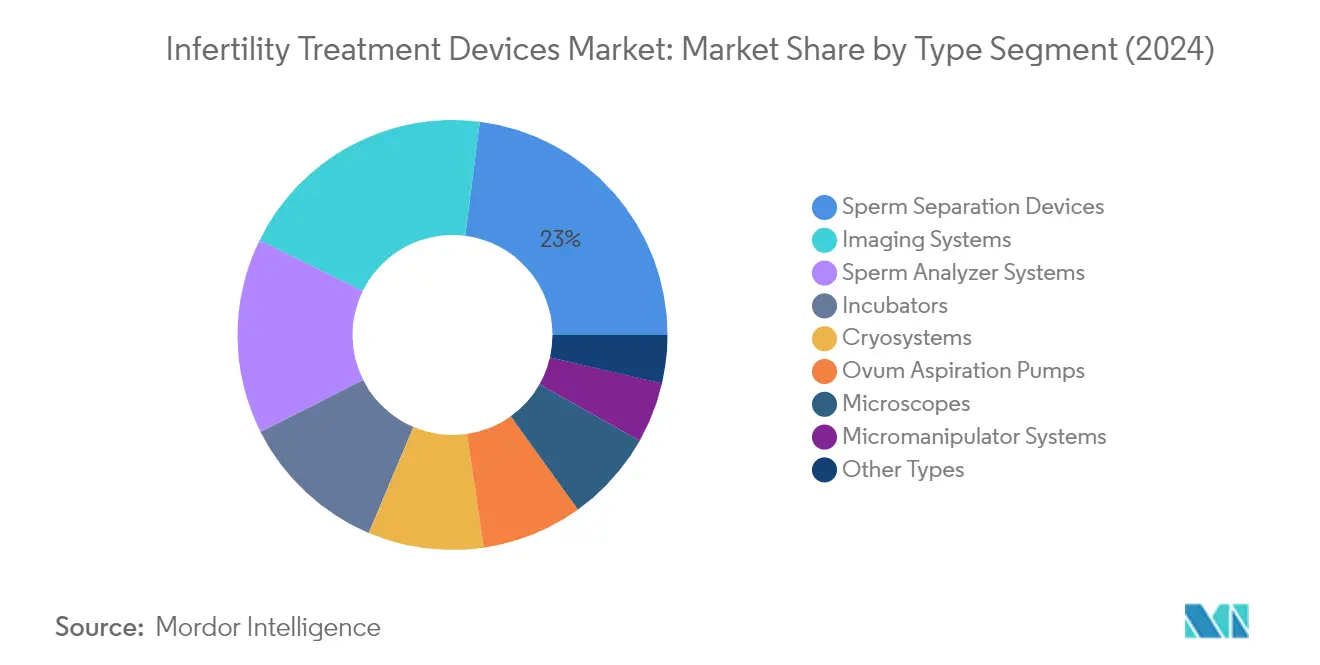
Remaining Segments in Infertility Treatment Devices Market
The market encompasses several other crucial segments, including imaging systems, sperm analyzer systems, incubators, cryopreservation equipment, ovum aspiration pumps, microscopes, micromanipulator systems, and other specialized devices. Imaging systems represent the second-largest segment, playing a vital role in monitoring and evaluating fertility treatments. Sperm analyzer systems and incubators are essential for maintaining optimal conditions for embryo development, while cryopreservation equipment provides critical preservation capabilities for reproductive materials. Ovum aspiration pumps and micromanipulator systems facilitate precise egg retrieval and manipulation procedures, and microscopes enable detailed examination of reproductive cells. Each of these segments contributes uniquely to the comprehensive ecosystem of infertility treatment, addressing different aspects of assisted reproductive technologies.
Segment Analysis: By End User
Fertility Clinics Segment in Infertility Treatment Devices Market
The fertility clinics segment dominates the infertility treatment devices market, commanding approximately 77% of the total market share in 2024. This segment's leadership position is attributed to the growing awareness about fertility treatments and the rising number of specialized fertility clinics worldwide. These clinics offer comprehensive family planning counseling to couples and develop personalized treatment plans based on the specific causes and severity of infertility. The segment's strong performance is further bolstered by increasing government initiatives supporting fertility treatments, such as the implementation of regulatory frameworks for assisted reproductive technology (ART) clinics. Additionally, fertility clinics are equipped with state-of-the-art technology and specialized staff, making them the preferred choice for couples seeking infertility treatments. The segment is also experiencing the fastest growth rate in the market, driven by the expanding network of fertility clinics in both developed and developing regions, along with increasing investments in advanced fertility treatment technologies.
Remaining Segments in Infertility Treatment Devices Market
The hospitals and other healthcare facilities segment, along with clinical research institutes, constitute important components of the infertility treatment devices market. Hospitals and healthcare facilities offer comprehensive fertility treatments integrated with other medical services, providing patients with complete maternity care through childbirth. These facilities benefit from the support of multiple departments, including neonatal intensive care units, making them a reliable choice for complex cases. Meanwhile, clinical research institutes play a crucial role in advancing fertility treatments through research and development activities. These institutes conduct various clinical studies and trials focused on new interventions for diagnosing and treating conditions related to reproductive endocrinology and infertility, contributing to the overall advancement of fertility treatment technologies and methodologies. The cryopreservation equipment market is also gaining traction as these institutes explore innovative preservation techniques.
Infertility Treatment Devices Market Geography Segment Analysis
Infertility Treatment Devices Market in North America
The North American infertility treatment devices market demonstrates robust growth driven by advanced healthcare infrastructure and increasing adoption of assisted reproductive technologies. The United States leads the regional market, followed by Canada and Mexico. The region benefits from supportive government policies, high healthcare expenditure, and growing awareness about fertility treatments. The presence of major market players and continuous technological innovations in the IVF devices market further strengthen the market position in North America.
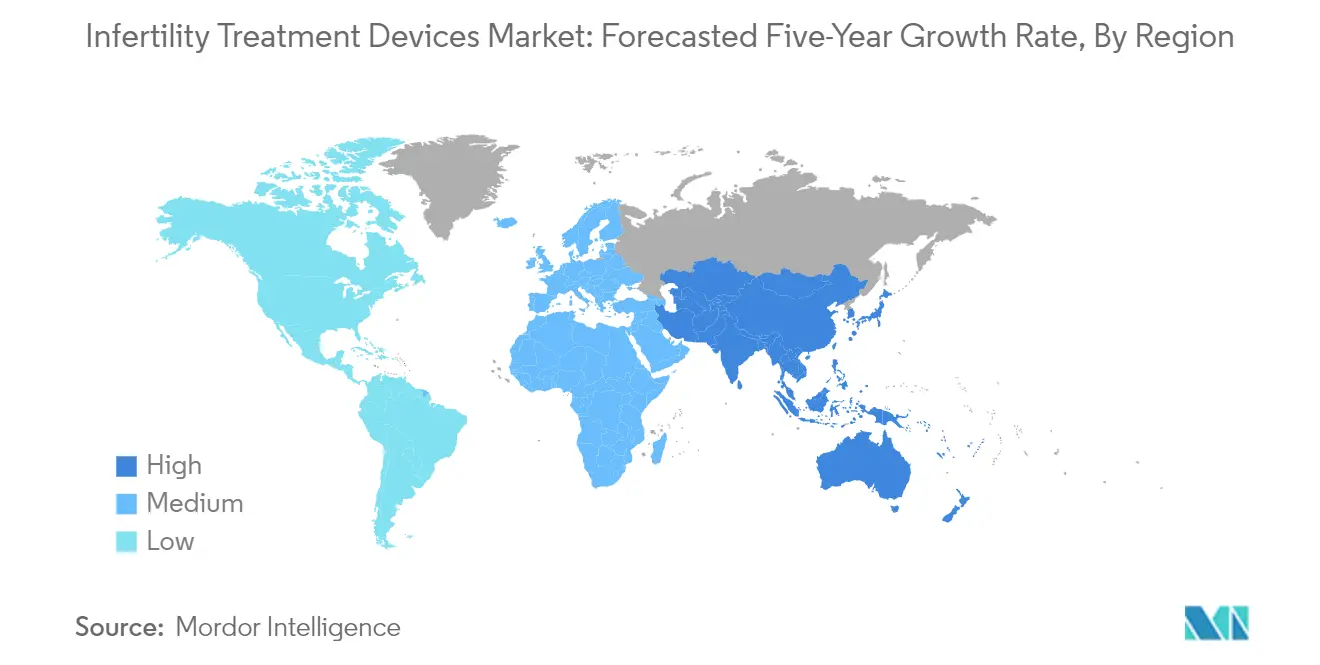
Infertility Treatment Devices Market in United States
The United States dominates the North American market with approximately 35% market share in 2024. The country's market leadership is attributed to the increasing prevalence of infertility in both males and females, coupled with the rising adoption of advanced fertility treatments. The presence of well-established fertility clinics, favorable reimbursement policies, and continuous product launches by key market players contribute to market growth. The country has witnessed significant developments in fertility treatment technologies, particularly in areas such as sperm separation devices and fertility monitoring devices.
Infertility Treatment Devices Market in Canada
Canada emerges as the fastest-growing market in North America, with a projected growth rate of approximately 5% during 2024-2029. The growth is driven by increasing government initiatives supporting fertility treatments and rising awareness about reproductive health. The country's healthcare system provides substantial coverage for fertility treatments in several provinces, making treatments more accessible to the population. The presence of advanced fertility clinics and increasing adoption of innovative fertility equipment contribute to the market's rapid expansion.
Infertility Treatment Devices Market in Europe
The European market for infertility treatment devices showcases significant growth potential, supported by advanced healthcare infrastructure and increasing fertility tourism. The region comprises key markets including the United Kingdom, Germany, France, Italy, and Spain. Each country contributes uniquely to market growth through different healthcare policies and adoption rates of fertility treatments. The presence of established fertility clinics and continuous technological advancements in in vitro fertilization equipment further strengthen the market.
Infertility Treatment Devices Market in United Kingdom
The United Kingdom maintains its position as the largest market in Europe, holding approximately 21% of the regional market share in 2024. The country's strong market presence is attributed to its advanced healthcare system and comprehensive fertility treatment coverage through the National Health Service (NHS). The UK has established itself as a hub for fertility treatments, with numerous specialized fertility clinics offering advanced treatment options and utilizing state-of-the-art fertility equipment.
Infertility Treatment Devices Market in France
France demonstrates the highest growth potential in Europe, with an expected growth rate of approximately 6% during 2024-2029. The country's market growth is driven by supportive government policies and increasing coverage of assisted reproductive technologies. France has implemented progressive legislation regarding fertility treatments, making them more accessible to a broader population. The presence of advanced fertility clinics and increasing adoption of innovative fertility technologies contribute to the market's expansion.
Infertility Treatment Devices Market in Asia-Pacific
The Asia-Pacific region represents a significant market for infertility treatment devices, characterized by increasing awareness about fertility treatments and improving healthcare infrastructure. The region encompasses major markets including Japan, China, India, Australia, and South Korea. The market growth is driven by the rising prevalence of infertility, changing lifestyle factors, and increasing healthcare expenditure across these countries.
Infertility Treatment Devices Market in Japan
Japan maintains its position as the largest market in the Asia-Pacific region. The country's market leadership is attributed to its advanced healthcare infrastructure and high adoption rate of fertility treatments. Japan has established itself as a pioneer in assisted reproductive technologies, with numerous specialized fertility clinics offering cutting-edge treatment options. The country's aging population and government initiatives supporting fertility treatments further drive market growth.
Infertility Treatment Devices Market in China
China emerges as the fastest-growing market in the Asia-Pacific region. The country's rapid market growth is driven by increasing awareness about fertility treatments, rising disposable income, and improving healthcare infrastructure. China has witnessed a significant increase in the number of fertility clinics and the adoption of advanced in vitro fertilization equipment. The government's initiatives to address declining fertility rates and support for assisted reproductive technologies contribute to market expansion.
Infertility Treatment Devices Market in Middle East & Africa
The Middle East & Africa region demonstrates growing potential in the infertility treatment devices market, with GCC countries and South Africa leading the regional growth. The market is driven by increasing healthcare expenditure, rising awareness about fertility treatments, and improving healthcare infrastructure. The GCC region emerges as the largest market, while South Africa shows the fastest growth potential. The region benefits from medical tourism and increasing investments in healthcare infrastructure, particularly in fertility clinics and specialized treatment centers.
Infertility Treatment Devices Market in South America
The South American market for infertility treatment devices shows promising growth potential, with Brazil and Argentina emerging as key markets in the region. The market is characterized by increasing awareness about fertility treatments, improving healthcare infrastructure, and rising healthcare expenditure. Brazil maintains its position as the largest market in the region, while also demonstrating the fastest growth rate. The region benefits from medical tourism, particularly due to competitive treatment costs and the presence of advanced fertility clinics.
Infertility Treatment Devices Industry Overview
Top Companies in Infertility Treatment Devices Market
The competitive landscape is characterized by continuous product innovation and technological advancement across major players like Cooper Companies, Cook Medical, Vitrolife, Hamilton Thorne, and Merck KGaA. Companies are heavily investing in research and development to introduce sophisticated fertility equipment with enhanced precision and success rates for fertility treatments. Strategic collaborations and licensing agreements have become increasingly common as firms seek to expand their product portfolios and geographical reach. Market leaders are focusing on developing integrated solutions that combine hardware, software, and consumables to provide comprehensive fertility treatment solutions. The industry has witnessed significant expansion through both organic growth and acquisitions, particularly in emerging markets across Asia-Pacific and Latin America. Companies are also emphasizing service-based offerings and post-sale support to create additional revenue streams and strengthen customer relationships.
Market Structure Shows Balanced Competition Dynamic
The infertility treatment devices market exhibits a mix of global conglomerates and specialized fertility technology providers, creating a dynamic competitive environment. Large multinational corporations like Merck KGaA and Cooper Companies leverage their extensive resources and global distribution networks, while specialized players such as Hamilton Thorne and IVFtech maintain strong positions through focused innovation in specific product categories. The market demonstrates moderate consolidation, with leading players actively pursuing strategic acquisitions to strengthen their market position and expand their technological capabilities. Regional players maintain a significant presence in their respective territories through strong local relationships and customized product offerings.
The industry is characterized by high barriers to entry due to stringent regulatory requirements and substantial capital investments needed for product development and commercialization. Market participants are increasingly focusing on vertical integration strategies, encompassing everything from device manufacturing to clinical support services. Cross-border partnerships and technology transfers have become crucial for market expansion, particularly in developing regions where fertility treatment infrastructure is rapidly evolving. The competitive dynamics are further shaped by the growing trend of fertility clinics seeking comprehensive solution providers rather than individual product suppliers.
Innovation and Service Integration Drive Success
Success in the infertility treatment devices market increasingly depends on companies' ability to deliver integrated solutions that combine advanced technology with comprehensive support services. Incumbent players are strengthening their market positions by investing in next-generation technologies, expanding their distribution networks, and developing closer relationships with fertility clinics and healthcare providers. The ability to provide end-to-end solutions, from diagnostic tools to treatment devices, along with robust after-sales support, has become crucial for maintaining a competitive advantage. Companies are also focusing on developing user-friendly interfaces and automated systems to improve clinical workflow efficiency and treatment outcomes.
For emerging players and contenders, success lies in identifying and exploiting niche market segments while building strong relationships with key stakeholders in the fertility treatment ecosystem. The increasing concentration of end-users in specialized fertility clinics necessitates strategic partnerships and customized solution offerings. While substitution risk from alternative fertility treatments exists, the technical sophistication of modern IVF devices creates significant switching costs for users. Regulatory compliance remains a critical success factor, with companies needing to maintain robust quality management systems and stay ahead of evolving regulatory requirements. Future market leadership will likely be determined by the ability to balance innovation with cost-effectiveness while maintaining strong relationships with healthcare providers and regulatory bodies.
Infertility Treatment Devices Market Leaders
-
CooperSurgical Inc
-
Hamilton Thorne Inc
-
Cook Medical Inc
-
Vitrolife
-
Dxnow (ZyMōt Fertility, Inc.)
- *Disclaimer: Major Players sorted in no particular order
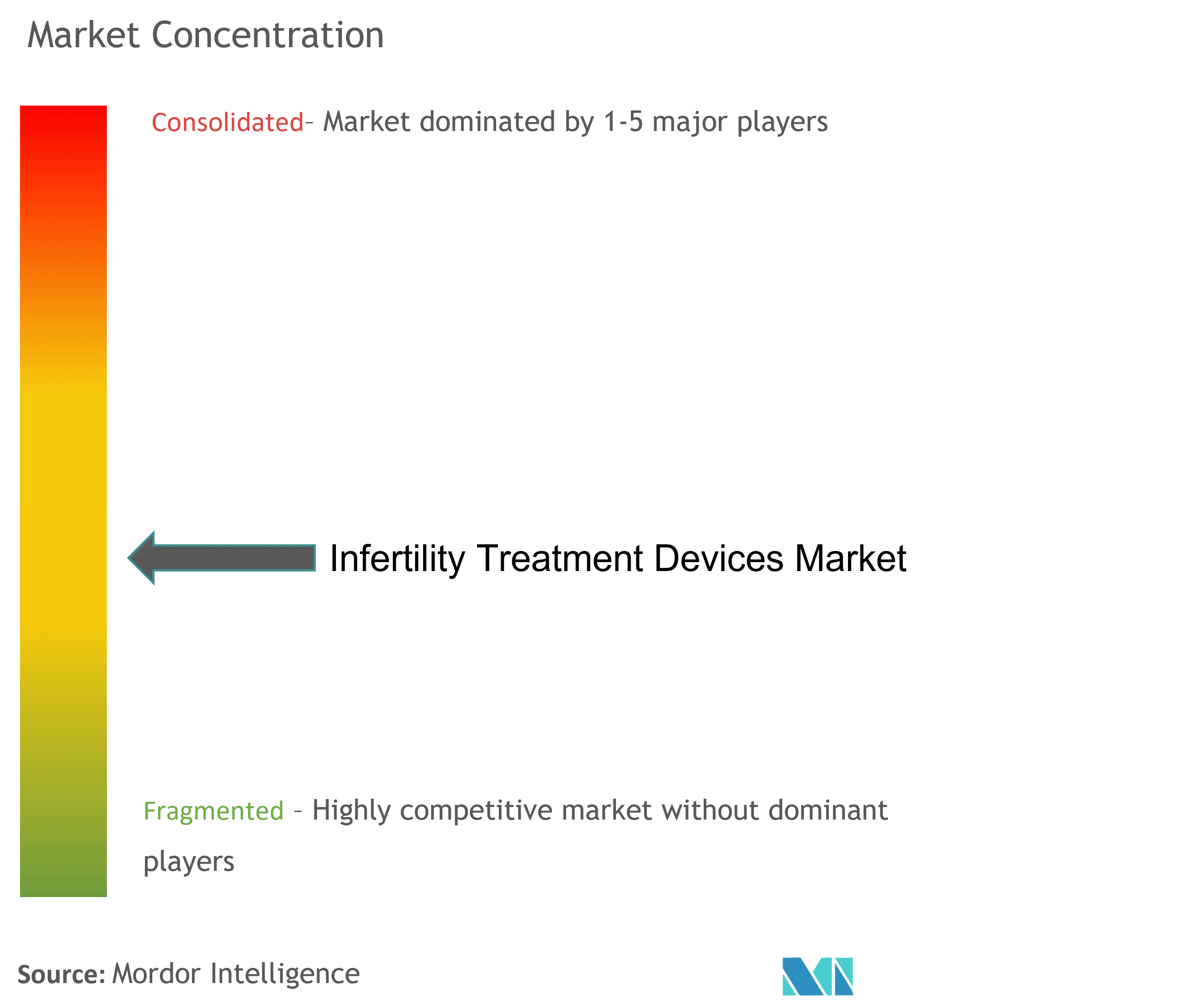
Infertility Treatment Devices Market News
- In September 2022, US Fertility launched the US Fertility Innovation Fund. The Innovation Fund will find, assess, and fund early-stage businesses that have the potential to influence the fertility industry's future and enhance patient care access and quality.
- In July 2022, Cellink, partnered with Spermosens, Malmö University, and Saint Louis University (SLU) to develop a diagnostic device to identify male infertility.
Infertility Treatment Devices Market Report - Table of Contents
1. INTRODUCTION
- 1.1 Study Assumptions and Market Definition
- 1.2 Scope of the Study
2. RESEARCH METHODOLOGY
3. EXECUTIVE SUMMARY
4. MARKET DYNAMICS
- 4.1 Market Overview
-
4.2 Market Drivers
- 4.2.1 Rise in Infertility and Prevalence of Conditions Such as Polycystic Ovary Syndrome (PCOS)
- 4.2.2 Increased Incidences of Infertility In Both Sexes
-
4.3 Market Restraints
- 4.3.1 Lack of Availability to People Due to Higher Cost of IVF Procedures
- 4.3.2 Possible Risk of Baby Being Born with Birth Defects, Risks of Infections and Unfavorable Scarring
-
4.4 Porter's Five Force Analysis
- 4.4.1 Threat of New Entrants
- 4.4.2 Bargaining Power of Buyers/Consumers
- 4.4.3 Bargaining Power of Suppliers
- 4.4.4 Threat of Substitute Products
- 4.4.5 Intensity of Competitive Rivalry
5. MARKET SEGMENTATION (Market Size by Value - USD million)
-
5.1 By Type
- 5.1.1 Sperm Separation Devices
- 5.1.2 Ovum Aspiration Pumps
- 5.1.3 Sperm Analyzer Systems
- 5.1.4 Micromanipulator Systems
- 5.1.5 Incubators
- 5.1.6 Cryosystems
- 5.1.7 Imaging Systems
- 5.1.8 Microscopes
- 5.1.9 Others
-
5.2 By End-user
- 5.2.1 Fertility Clinics
- 5.2.2 Hospitals & Other Healthcare Facilities
- 5.2.3 Clinical Research Institutes
-
5.3 Geography
- 5.3.1 North America
- 5.3.1.1 United States
- 5.3.1.2 Canada
- 5.3.1.3 Mexico
- 5.3.2 Europe
- 5.3.2.1 Germany
- 5.3.2.2 United Kingdom
- 5.3.2.3 France
- 5.3.2.4 Italy
- 5.3.2.5 Spain
- 5.3.2.6 Rest of Europe
- 5.3.3 Asia-Pacific
- 5.3.3.1 China
- 5.3.3.2 Japan
- 5.3.3.3 India
- 5.3.3.4 Australia
- 5.3.3.5 South Korea
- 5.3.3.6 Rest of Asia-Pacific
- 5.3.4 Middle East and Africa
- 5.3.4.1 GCC
- 5.3.4.2 South Africa
- 5.3.4.3 Rest of Middle East and Africa
- 5.3.5 South America
- 5.3.5.1 Brazil
- 5.3.5.2 Argentina
- 5.3.5.3 Rest of South America
6. COMPETITIVE LANDSCAPE
-
6.1 Company Profiles
- 6.1.1 AB Scientific Ltd
- 6.1.2 Cook Medical Inc
- 6.1.3 CooperSurgical Inc
- 6.1.4 Dxnow (ZyMōt Fertility, Inc.)
- 6.1.5 Eppendorf Ag
- 6.1.6 Esco Micro Pte Ltd
- 6.1.7 Hamilton Thorne Inc
- 6.1.8 Ivftech Aps
- 6.1.9 MedGyn Products
- 6.1.10 Merck KgaA
- 6.1.11 Rocket Medical Plc
- 6.1.12 Vitrolife
- *List Not Exhaustive
7. MARKET OPPORTUNITIES AND FUTURE TRENDS
Infertility Treatment Devices Industry Segmentation
As per the scope of the report, infertility treatment devices are used in assisted reproductive treatments (ARTs) such as IVFs, imaging systems, and other techniques employed in the several options for patient treatment depending on the causes of infertility. Healthcare facilities specializing in ART treatments require a license from the respective authorities present in the country. The Infertility Treatment Devices Market Is Segmented By Type (Sperm Separation Devices, Ovum Aspiration Pumps, Sperm Analyzer Systems, Micromanipulator Systems, Incubators, Cryosystems, Imaging Systems, Microscopes, and Others), End User (Fertility Clinics, Hospitals & Other Healthcare Facilities, and Clinical Research Institutes), and Geography (North America, Europe, Asia-Pacific, Middle East And Africa, and South America). The market report also covers the estimated market sizes and trends for 17 different countries across the major regions globally. The report offers the values (USD million) for the above segments.
| By Type | Sperm Separation Devices | ||
| Ovum Aspiration Pumps | |||
| Sperm Analyzer Systems | |||
| Micromanipulator Systems | |||
| Incubators | |||
| Cryosystems | |||
| Imaging Systems | |||
| Microscopes | |||
| Others | |||
| By End-user | Fertility Clinics | ||
| Hospitals & Other Healthcare Facilities | |||
| Clinical Research Institutes | |||
| Geography | North America | United States | |
| Canada | |||
| Mexico | |||
| Europe | Germany | ||
| United Kingdom | |||
| France | |||
| Italy | |||
| Spain | |||
| Rest of Europe | |||
| Asia-Pacific | China | ||
| Japan | |||
| India | |||
| Australia | |||
| South Korea | |||
| Rest of Asia-Pacific | |||
| Middle East and Africa | GCC | ||
| South Africa | |||
| Rest of Middle East and Africa | |||
| South America | Brazil | ||
| Argentina | |||
| Rest of South America | |||
Infertility Treatment Devices Market Research FAQs
How big is the Infertility Treatment Devices Market?
The Infertility Treatment Devices Market size is expected to reach USD 2.21 billion in 2025 and grow at a CAGR of 5.78% to reach USD 2.93 billion by 2030.
What is the current Infertility Treatment Devices Market size?
In 2025, the Infertility Treatment Devices Market size is expected to reach USD 2.21 billion.
Who are the key players in Infertility Treatment Devices Market?
CooperSurgical Inc, Hamilton Thorne Inc, Cook Medical Inc, Vitrolife and Dxnow (ZyMōt Fertility, Inc.) are the major companies operating in the Infertility Treatment Devices Market.
Which is the fastest growing region in Infertility Treatment Devices Market?
Asia Pacific is estimated to grow at the highest CAGR over the forecast period (2025-2030).
Which region has the biggest share in Infertility Treatment Devices Market?
In 2025, the North America accounts for the largest market share in Infertility Treatment Devices Market.
What years does this Infertility Treatment Devices Market cover, and what was the market size in 2024?
In 2024, the Infertility Treatment Devices Market size was estimated at USD 2.08 billion. The report covers the Infertility Treatment Devices Market historical market size for years: 2019, 2020, 2021, 2022, 2023 and 2024. The report also forecasts the Infertility Treatment Devices Market size for years: 2025, 2026, 2027, 2028, 2029 and 2030.
Our Best Selling Reports
Infertility Treatment Devices Market Research
Mordor Intelligence delivers a comprehensive analysis of the fertility equipment industry. We leverage our extensive experience in healthcare technology research to provide stakeholders with crucial data. Our expert analysts offer detailed insights into in vitro fertilization equipment and IVF devices. This information is essential for understanding market dynamics and technological innovations. The report, available as an easy-to-read downloadable PDF, covers extensive analysis of cryopreservation equipment and emerging technologies in reproductive medicine.
Our detailed research encompasses the complete spectrum of fertility monitoring devices and their applications. This provides valuable insights for healthcare providers and manufacturers. The analysis examines technological advancements in the fertility testing devices market and evaluates growth opportunities in the IVF devices market. Special attention is given to developments in the cryopreservation equipment market. This offers stakeholders actionable intelligence for strategic decision-making. The report delivers precise forecasts, competitive analysis, and regulatory insights. These enable businesses to optimize their market strategies and operational efficiency.




